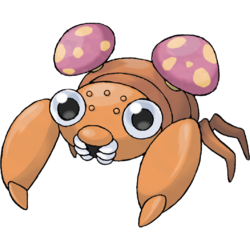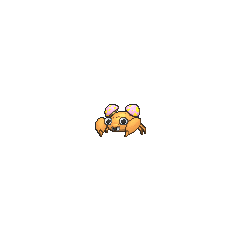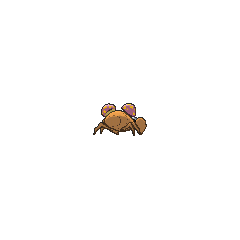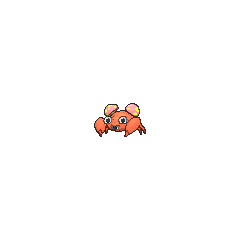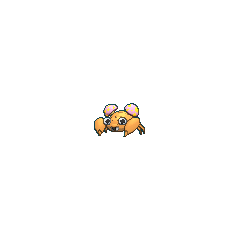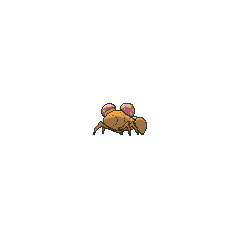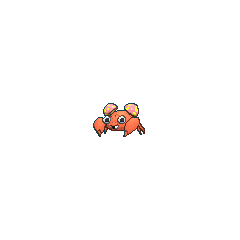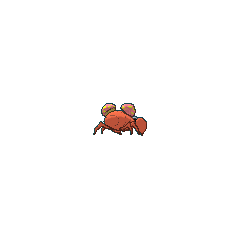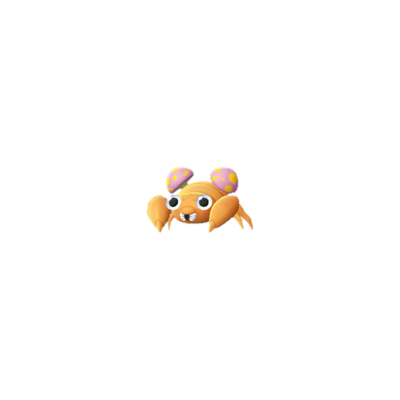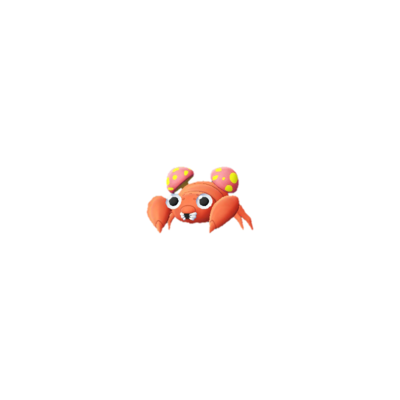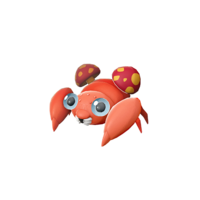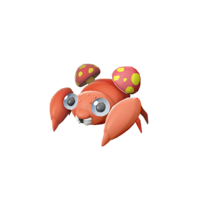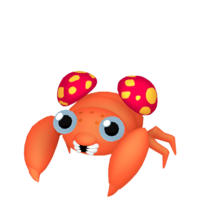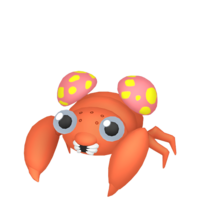Paras (Japanese: パラス Paras) is a dual-type Bug/Grass Pokémon introduced in Generation I.
It evolves into Parasect starting at level 24.
Biology
Paras is an orange, insectoid Pokémon that resembles the nymph stage of a cicada. Its ovoid body is segmented, and it has three pairs of legs. The foremost pair of legs is the largest and has sharp claws at the tips. There are five specks on its forehead and three teeth on either side of its mouth. It has circular eyes with large pseudopupils.
Red-and-yellow mushrooms known as tochukaso grow on this Pokémon's back. The mushrooms can be removed at any time and grow from spores that are doused on this Pokémon's back at birth by the mushroom on its mother's back. Tochukaso are parasitic in nature, drawing their nutrients from the host Paras's body in order to grow and exerting some command over the Pokémon's actions. For example, Paras drains nutrients from tree roots due to commands from the mushrooms. The mushrooms are also popular among collectors and have medicinal uses, usually involving extended life. Prior to Generation III, Spore was its signature move.
The anime has shown that Paras can often be found in caves. However, it can also thrive in damp forests. In the Alola region, the mushrooms on its back do not grow well. This is thought to be from a lack of moisture or nutrients.
In the anime
Major appearances
In The Problem with Paras, Cassandra owns a Paras that is extremely weak, but she needed it to evolve into a Parasect so she could use its giant mushroom to aid her in her medical research. It did so towards the end of the episode.
Minor appearances
Multiple Paras debuted in Clefairy and the Moon Stone, where they were removing the mushrooms on their backs. Seymour explained that this behavior was due to someone stringing lights in the caves of Mt. Moon, and implied that this was not good for them.
In Bulbasaur and the Hidden Village, a Paras was under Melanie's care. It reappeared in a flashback in Bulbasaur... the Ambassador!.
In Pokémon Fashion Flash, a Paras was on Scissor Street.
A Paras appeared in A Chansey Operation.
A Paras appeared in The Breeding Center Secret.
In Pikachu's Vacation, a Paras was at the Pokémon Theme Park.
In Showdown at the Po-ké Corral, multiple Paras were living at Professor Oak's Laboratory.
Two Paras of the Valencia Island variant appeared in Poké Ball Peril.
In In the Pink, a pink Paras was a resident of Pinkan Island.
In Tracey Gets Bugged, a Paras was on Murcott Island.
In The Power of One, a Paras sensed the disturbance caused by Lawrence III.
A wild Paras appeared in Pikachu's Rescue Adventure.
In The Fortune Hunters, a Paras was stolen by Butch and Cassidy.
In The Bug Stops Here, a Paras was chased away by Misty after it scared her.
In The Grass Route, a Trainer's Paras competed in the Grass Tournament.
A Paras appeared in Celebi: The Voice of the Forest.
In Got Miltank?, a Paras was an inhabitant of a Pokémon-exclusive oasis.
A Paras appeared in A Bite to Remember.
A Paras appeared in Destiny Deoxys.
A Paras appeared in the opening sequence of Lucario and the Mystery of Mew.
A Coordinator's Paras appeared in Harley Rides Again.
In Once More With Reeling!, a Coordinator's Paras participated in the Terracotta Contest.
A Paras appeared in Borrowing on Bad Faith!.
In Genesect and the Legend Awakened, multiple Paras were residents of Pokémon Hills.
A Trainer's Paras appeared in Alola to New Adventure!.
In Lillie's Egg-xhilarating Challenge!, a Paras was playing in Lillie's garden. It reappeared in The Ol' Raise and Switch!.
In I Choose You!, a Paras taking shelter from the rain in a cave alongside Entei.
In Alola, Kanto!, multiple Paras were seen at Professor Oak's Laboratory.
Five Trainers' Paras appeared in A Young Royal Flame Ignites!.
Five Paras appeared in The Power of Us, with four under the ownership of different Trainers and the fourth being wild.
Three Paras appeared in Securing the Future!, with two under the ownership of different Trainers and the third being wild. They joined the rest of Alola in showering Necrozma with light so it could return to its true form.
In The Battlefield of Truth and Love!, a Paras was watching Bewear and Stufful put on a performance in their hot springs.
In Working My Way Back to Mew!, Goh caught a Paras. It has since made further appearances in Pokémon Journeys: The Series.
Multiple Paras appeared in a fantasy in Trade, Borrow, and Steal!.
A Trainer's Paras appeared in Take My Thief! Please!.
A Paras appeared in This Could be the Start of Something Big!.
A Paras appeared in JNS05.
A Paras appeared in The Rainbow and the Pokémon Master!.
Pokédex entries
| Episode
|
Subject
|
Source
|
Entry
|
| EP044
|
Paras
|
Ash's Pokédex
|
Paras, the Mushroom Pokémon. Rare mushrooms grow on its back.
|
| EP044
|
Paras's type
|
Ash's Pokédex
|
Paras has qualities of both Bug and Grass Pokémon.
|
|
In the manga
Pokémon Adventures
In Purrrr-sian, Super Nerd Miles, disguised as Red, used a Paras during an attempt to catch Pika, who was with Yellow at the time. It used its spores, attacking alongside his Persian and Marowak.
In The Last Battle XIII, a Paras was sent to participate in the fight in Ilex Forest.
Pokémon Gold & Silver: The Golden Boys
A Trainer's Paras appeared in Let's Fight For The Future!!.
Pokémon Gotta Catch 'Em All
A Paras appeared in A Match For Pokémon.
A Paras appeared in The Challenge at Celadon University!.
In the TCG
- Main article: Paras (TCG)
Game data
Pokédex entries
| Generation I
|
|
|
Kanto
#046
|
| Red(ENG)
|
Burrows to suck tree roots. The mushrooms on its back grow by drawing nutrients from the bug host.
|
| Blue
|
| Yellow
|
Burrows under the ground to gnaw on tree roots. The mushrooms on its back absorb most of the nutrition.
|
| Stadium
|
Grows by sucking nutrients from the roots of trees. The mushrooms on its back grow by drawing extracts from the bug host.
|
|
|
| Generation II
|
|
|
Johto
#070
|
| Gold
|
It is doused with mushroom spores when it is born. As its body grows, mushrooms sprout from its back.
|
| Silver
|
As its body grows large, oriental mushrooms called tochukaso start sprouting out of its back.
|
| Crystal
|
The tochukaso growing on this Pokémon's back orders it to extract juice from tree trunks.
|
| Stadium 2
|
It is doused with mushroom spores when it is born. As its body grows, mushrooms sprout from its back.
|
|
|
| Generation III
|
|
Hoenn
#—
|
|
Kanto
#046
|
| Ruby
|
Paras has parasitic mushrooms growing on its back called tochukaso. They grow large by drawing nutrients from this Bug/Grass Pokémon host. They are highly valued as a medicine for extending life.
|
| Sapphire
|
| Emerald
|
A Paras has parasitic tochukaso mushrooms growing on its back. They grow by drawing nutrients from the host. They are valued as a medicine for long life.
|
| FireRed
|
Growing out of the bug's back are mushrooms called tochukaso. The mushrooms grow with the bug host.
|
| LeafGreen
|
Burrows to suck tree roots. The mushrooms on its back grow by drawing nutrients from the bug host.
|
|
|
| Generation IV
|
|
Sinnoh
#—
|
|
Johto
#070
|
| Diamond
|
Mushrooms named tochukaso grow on its back. They grow along with the host Paras.
|
| Pearl
|
| Platinum
|
| HeartGold
|
It is doused with mushroom spores when it is born. As its body grows, mushrooms sprout from its back.
|
| SoulSilver
|
As its body grows, large mushrooms named tochukaso start sprouting out of its back.
|
|
|
| Generation V
|
|
|
Unova
#—
|
| Black
|
Mushrooms named tochukaso grow on its back. They grow along with the host Paras.
|
| White
|
| Black 2
|
Mushrooms named tochukaso grow on its back. They grow along with the host Paras.
|
| White 2
|
|
|
| Generation VI
|
|
Kalos
#—
|
|
Hoenn
#—
|
| X
|
Growing out of the bug's back are mushrooms called tochukaso. The mushrooms grow with the bug host.
|
| Y
|
Burrows under the ground to gnaw on tree roots. The mushrooms on its back absorb most of the nutrition.
|
| Omega Ruby
|
Paras has parasitic mushrooms growing on its back called tochukaso. They grow large by drawing nutrients from this Bug Pokémon host. They are highly valued as a medicine for extending life.
|
| Alpha Sapphire
|
|
|
| Generation VII
|
|
Alola
SM: #147
|
|
Alola
USUM: #180
|
|
Kanto
#046
|
| Sun
|
No matter how much it eats, the mushrooms growing on its back steal away most of the nutrients it consumes.
|
| Moon
|
Mushrooms called tochukaso sprout from its back. They can be dried and powdered to make a medicine used to extend life.
|
| Ultra Sun
|
Whether it's due to a lack of moisture or a lack of nutrients, in Alola the mushrooms on Paras don't grow up quite right.
|
| Ultra Moon
|
The mushrooms, known as tochukaso, are controlling the bug. Even if the bug bugs the mushrooms, they tell it to bug off.
|
| Let's Go Pikachu
|
Burrows under the ground to gnaw on tree roots. The mushrooms on its back absorb most of the nutrition.
|
| Let's Go Eevee
|
|
|
| Generation VIII
|
|
Galar
#—
|
|
Sinnoh
#—
|
|
Hisui
#053
|
| This Pokémon has no Pokédex entries in Sword and Shield.
|
| Brilliant Diamond
|
Mushrooms named tochukaso grow on its back. They grow along with the host Paras.
|
| Shining Pearl
|
| Legends: Arceus
|
Sometimes seen at the foot of trees in humid forests. The mushrooms on its back—called tochukaso—are not present on infant specimens and instead emerge as Paras matures.
|
|
|
|
|
Game locations
In side games
|
|
| Generation II
|
|
| This Pokémon is unavailable in Generation II side games.
|
|
|
|
|
|
|
|
|
|
|
|
|
|
|
|
|
In events
Held items
Stats
Base stats
| Stat
|
Range
|
| At Lv. 50
|
At Lv. 100
|
35
|
|
95 - 142
|
180 - 274
|
70
|
|
67 - 134
|
130 - 262
|
55
|
|
54 - 117
|
103 - 229
|
45
|
|
45 - 106
|
85 - 207
|
55
|
|
54 - 117
|
103 - 229
|
25
|
|
27 - 84
|
49 - 163
|
Total: 285
|
Other Pokémon with this total
|
- Minimum stats are calculated with 0 EVs, IVs of 0, and (if applicable) a hindering nature.
- Maximum stats are calculated with 252 EVs, IVs of 31, and (if applicable) a helpful nature.
- This Pokémon's Special base stat in Generation I was 55.
|
Pokéathlon stats
Type effectiveness
| Under normal battle conditions in Generation IX, this Pokémon is:
|
|
|
|
|
|
|
|
|
|
|
|
|
Learnset
Paras is available in Brilliant Diamond and Shining Pearl and Pokémon Legends: Arceus.
BDSP
|
|
|
|
- Bold indicates a move that gets STAB when used by Paras
- Italic indicates a move that gets STAB only when used by an Evolution of Paras
- Click on the generation numbers at the top to see level-up moves from other generations
|
LA
|
|
|
|
- Bold indicates a move that gets STAB when used by Paras
- Italic indicates a move that gets STAB only when used by an Evolution of Paras
- Click on the generation numbers at the top to see level-up moves from other generations
|
|
|
|
|
- Bold indicates a move that gets STAB when used by Paras
- Italic indicates a move that gets STAB only when used by an Evolution of Paras
- Click on the generation numbers at the top to see TM moves from other generations
|
|
|
|
|
- Moves marked with an asterisk (*) must be chain bred onto Paras in Generation VIII
- Moves marked with a double dagger (‡) can only be bred from a Pokémon who learned the move in an earlier generation.
- Moves marked with a superscript game abbreviation can only be bred onto Paras in that game.
- Bold indicates a move that gets STAB when used by Paras
- Italic indicates a move that gets STAB only when used by an Evolution of Paras
- Click on the generation numbers at the top to see Egg moves from other generations
|
BDSP
|
|
|
|
- Bold indicates a move that gets STAB when used by Paras
- Italic indicates a move that gets STAB only when used by an Evolution of Paras
- Click on the generation numbers at the top to see Move Tutor moves from other generations
|
LA
|
|
|
|
- Bold indicates a move that gets STAB when used by Paras
- Italic indicates a move that gets STAB only when used by an Evolution of Paras
- Click on the generation numbers at the top to see Move Tutor moves from other generations
|
TCG-only moves
Side game data
|
|
|
|
|
|
|
|
|
Pokémon Ranger
| Group:
|
|
Poké Assist:
|

|
Field move:
|

(Cut ×1)
|
| Loops: 4
|
Min. exp.: 13
|
Max. exp.: 24
|
Browser entry R-050
|
| Paras cuts the Capture Line with its front claws to avoid being caught.
|
|
|
|
|
|
Pokémon Rumble Rush

|
Walking Speed: 3.33 seconds
|
Base HP: 43
|
|
| Base Attack: 68
|
Base Defense: 49
|
Base Speed: 50
|
|
|
|
|
|
|
|
Evolution
Sprites
|
|
|
|
|
|
|
|
|
|
|
|
|
|
|
|
| This Pokémon is unavailable in Generation IX.
|
|
|
Trivia
- Early English promotional material for Pokémon Red and Blue listed Paras's name as Parasyte.
- In Generation I, Poison-type attacks were super effective against Bug-type Pokémon, making Paras and Parasect the only Pokémon to have ever had three 4× weaknesses.
- No other Pokémon has the same Egg Group combination as Paras and its evolution.
- Paras and Parasect share their species name with Shroomish, Breloom, Foongus, and Amoonguss. They are all known as the Mushroom Pokémon.
- Paras can be seen as a counterpart to Morelull. Both share the Grass type, the same base stat total of 285, evolve at Level 24, both are mushroom-based Pokémon and thus can learn Spore, and both can be found in the wild in Pokémon Sun and Moon, taking the place of the other depending on the time, with Paras being found during the day and Morelull at night.
- In the 1.0 release of the English versions of Pokémon Ruby and Sapphire, the Pokédex entry of Paras refers to it as BUG POKéMON. In the 1.1 release, this was modified to mention BUG/GRASS POKéMON instead. The Pokédex entry in Pokémon Omega Ruby and Alpha Sapphire says Bug Pokémon like Pokémon Ruby and Sapphire version 1.0, however.
- Normally, Paras' shiny doesn't change much, but in FireRed and LeafGreenonly, Paras has yellow mushrooms, and in Gold and Silver, it was mostly yellow.
Origin
Bulbanews has an article related to this subject:
The fungus on Paras is identified as tochukaso, an endoparasitoid that replaces the host tissue and can affect the behavior of its insect host. The base insect appears to be a cicada nymph. In concept, it could be inspired by ants that are infected with mushroom spores that take control of the host ant's brain and sprout from its head or back. It may also draw inspiration from Massospora, a genus of fungi which include species that specifically infect cicadas.
Name origin
Paras may be derived from parasite, referring to the parasitic mushroom growing on its back.
In other languages
| Language
|
Title
|
Meaning
|
 Japanese Japanese
|
パラス Paras
|
From parasite
|
 French French
|
Paras
|
Same as English/Japanese name
|
 Spanish Spanish
|
Paras
|
Same as English/Japanese name
|
 German German
|
Paras
|
Same as English/Japanese name
|
 Italian Italian
|
Paras
|
Same as English/Japanese name
|
 Korean Korean
|
파라스 Paras
|
Transcription of Japanese name
|
 Mandarin Chinese Mandarin Chinese
|
派拉斯 Pàilāsī
|
Transcription of Japanese name
|
 Cantonese Chinese Cantonese Chinese
|
派拉斯 Pāailāaisī*
蘑菇蟲 Mòhgūchùhng*
|
Transcription of Japanese name
From 蘑菇 mòhgū and 蟲 chùhng
|
|
|
|
| More languages
|
 Hebrew Hebrew
|
פרס Paras
|
Transcription of English name
|
 Hindi Hindi
|
पारस Paras
|
Transcription of English name
|
 Icelandic Icelandic
|
Sníkill*
|
From sníkill
|
 Lithuanian Lithuanian
|
Paras
|
Same as English name
|
 Russian Russian
|
Парас Paras
|
Transcription of English name
|
 Thai Thai
|
พารัส Pharat
|
Transcription of Japanese name
|
|
|
|
External links

|
This Pokémon article is part of Project Pokédex, a Bulbapedia project that aims to write comprehensive articles on each Pokémon species, as well as Pokémon groups and forms.
|
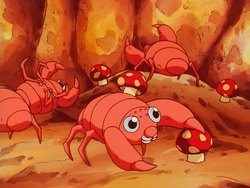


 For other sprites and images, please see Paras images on the Bulbagarden Archives.
For other sprites and images, please see Paras images on the Bulbagarden Archives.
